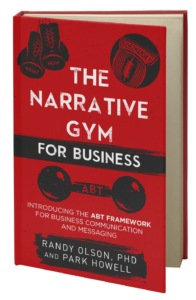I woke up this morning to this nice note on LinkedIn from Allan Rienstra:
“The ABT is the easiest change I’ve ever made to my customer correspondence style and with instant payback. But it took so little effort, therefore I’ll keep on writing this way for the rest of my days.”

I’ve been receiving a lot of these notes lately thanks to my appearance on Michael Stelzner’s excellent Social Media Examiner podcast. My episode is How to Sell More by Saying Less: A Storytelling Framework where I reveal how to use the ABT (And, But, Therefore) narrative framework in your content marketing.
You can listen to it here:
Plus, the show notes will walk you through how to craft an ABT to make all of your business communications clearer and more compelling.
But here’s the short course. Follow these steps exactly to start crafting your ABTs:
- Identify your target audience, what they want AND why it’s important to them.
- BUT detail why don’t they have it?
- THEREFORE, how will you help them get it?
The ABT is short and sweet but…
It’s tricky. The ABT narrative framework takes practice.
First, you have to get the setup/problem/resolution form down so it comes naturally. We call it building your narrative intuition so you stop boring prospects.
Think of the ABT as your storytelling dumbbell. You want to curl it every day in all of your communications to build your storytelling muscle memory.
That’s ABT 101.
Give it tons of reps daily.
Then you want to make your ABTs even more effective using the What/How tool. What is your problem and how does it happen? What is your solution and how does it manifest itself? Our cause and effect primal brain loves this content order. That’s ABT 201.
Practice, practice.
ABT 301 is the use of the If/Then tool to make your statement of agreement and even your problem statement more specific and therefore more compelling.
My co-author, Randy Olson, preaches that the power of storytelling rests in the specifics. The If/Then helps you with the specifics.
You want to connect with your prospect on a primal level and if you use the ABT properly then you will more likely convert them into a customer.
But you’re not getting the sale because you’re boring your audience with features and functions and logic and reason when what they want is the emotional appeal of a story.
Therefore, hook the primal cause and effect brain where all of their real buying decisions are being made using the three forces of storytelling – agreement, contradiction and consequence – that is the ABT (And, But, Therefore) narrative framework.
Don’t even get me started on the power of the word “because” in your problem statement. Or how to use the ABT as a framing device, listening tool, etc.
 I don’t have time here. But you can learn it quickly in our new book The Narrative Gym for Business. What Strunk & White’s Elements of Style is to writing, our 75-page guide is to the elements of simple and effective storytelling.
I don’t have time here. But you can learn it quickly in our new book The Narrative Gym for Business. What Strunk & White’s Elements of Style is to writing, our 75-page guide is to the elements of simple and effective storytelling.
Plus, you can take the companion quick online course, The ABTs of Selling™. In under 18 minutes through three short videos, I’ll teach you the elements of the ABT and how you can apply them immediately to grow as a more confident, compelling and persuasive communicator.
Alan also said,
“What I love about guys like you is that 30 years into my career I can learn new things… simple things… impactful things… from people completely unconnected with my field of work.”
What I love is that I’m 35+ years into my career and I and the ABT are more useful than ever in brand, sales and marketing communications.
By the way, Allan is in the ultrasound business. I responded to his note by saying that the ABT is the ultrasound to birthing stories because it provides a clear view of a healthy narrative structure.
Sorry, I couldn’t help myself.











